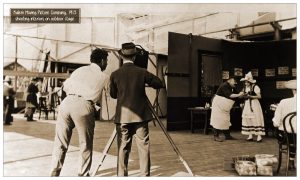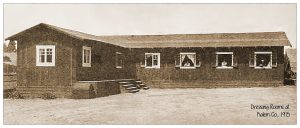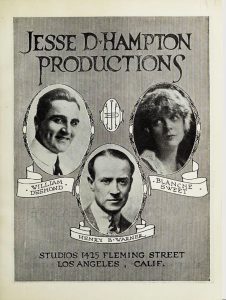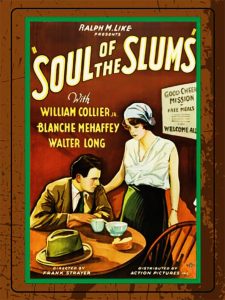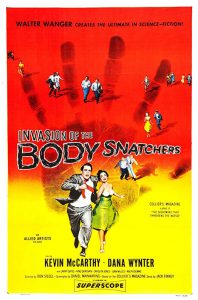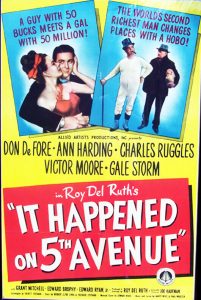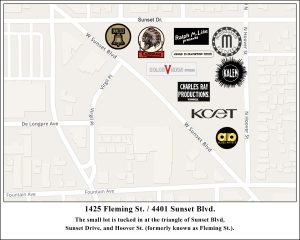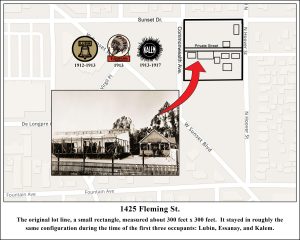1425 Fleming St.
Sunset Dr. and Fleming St.
The oldest studio in Hollywood and one of its most iconic
is still in production and has been for over 100 years
aka 1425 Hoover St., 4376 Sunset Dr., 1426 Commonwealth Ave., and 4401 Sunset Blvd.
Photo courtesy of Marc Wanamaker/Bison Archives click to enlarge
click to enlarge
Related Pages:
- Lubin main page
- Lubin's Philadelphia studios
- Lubin in Jacksonville
- Lubin's Coronado studio
- Essanay's main page
- Kalem's main page

The Essanay Co.
The Essanay Co.
Active 1913

Lubin Co. arrives from Philadelphia
Lubin Manufacturing Co.
1425 Fleming St. (now Hoover) at Sunset Dr. (aka 4376 Sunset Dr.)
Active 1912-1913
Born in 1851 in present day Poland, Siegmund "Pop" Lubin emigrated to the U.S in 1876. By the time he erected this little East Hollywood studio in 1912, he was well established in the business. He was one of the original movie moguls and ran an extremely successful business. Lubin Manufacturing Co. opened its first studio on a rooftop in Philadelphia in 1897. It was America's second formal movie studio.
As Lubin's profits grew he expanded to a second studio, Lubinville, in Philadelphia. In 1912 he bought the 360 Betzwood Estate near Valley Forge, as his third studio where he built a western town and shot his very successful Toonerville Trolley series.
Finding the cold Pennsylvania Winters limited his production, he built studios in sunny Jacksonville, Florida and this property in East Hollywood, California, though he never actually set foot in California.
Lubin bought this property at 1425 Fleming St. (now Hoover) in February of 1912. He made this his West Coast home. It was a small lot, extending 300 feet along Sunset Drive between Fleming and the now defunct Commonwealth St. and 300 feet south along Fleming. The facility consisted of a small house for offices and dressing rooms, and a small outdoor shooting stage. A provate street bisected the lot between Commonwealth and Fleming (see the maps).
Lubin Company's stay in East Hollywood lasted less than a year. In June the studio closed, a move meant to be temporary. Lubin sold the property to Essanay Company, and resettled in Coronado, close to San Diego.
By 1916 Lubin closed all his studios and declared bankruptcy. Siegmund "Pop" Lubin went back to his original occupation, Optometry.
By 1913 Hollywood was on the ascendance. All the large companies began to flock to the area.
After Lubin's short stay and move to San Diego, the Essanay Company was the next to arrive at the little studio. Its owners were George K. Spoor and actor G.M. "Bronco Billy" Anderson.
Essanay was already a well-established company. Chicago was, during the early days of the silent era, not only the nation's second city, but also the movie industry's second city. Essanay was the biggest of Chicago's movie studios. Founded in 1907, they took their name from the first letter the last names of its owners, putting "and" in between, and gave it a phonetic spelling. Hence "Essanay."
In 1912 they built a large studio complex in Northern California, moving most of their production to that newly built studio, at a small town called Niles (now a part of Fremont, CA across the bay from San Francisco). There they made some very popular westerns starring owner, Bronco Billy. He believed in the Western and thought success could be made of having a central character, Bronco Billy, in all their Westerns. He was right. He was a big star. They also hired popular comedy actor Charles Chaplin. It was in Niles that Chaplin made his early hit, "The Tramp."
1913 was their opportunity to move to the burgeoning movie colony of Hollywood. Niles was in full production, but they couldn't produce fast enough to keep up with the movie going appetite for their Westerns, so they added a Hollywood branch under the stewardship of J. Arthur Mackley.
Their stay at Fleming Street wouldn't be long, however. After making about 20 one-reelers over a period of 5 months, they called it quits and and moved on. Less than a year and they abandoned the tiny studio. A rift had developed between Anderson and Spoor. A disagreement over not resigning Chaplin, their big star, caused the rift. Spoor didn't want to pay Chaplin's demanded salary and Anderson saw Chaplin as the future of the company. Spoor bought out Anderson's shares and shut down this studio.
Essanay Company folded in 1917.

Kalem Company
Kalem Company
Active 1913-1917
The property sat vacant throughout the summer of 1913, but in October, Kalem Company arrived to take control of the little studio and stayed for four years.
Kalem started its life as a New York company and for its first year didn't even have a studio. Instead they moved their company of stock actors and directors across the country and the globe to make their films. They shot in Ireland, they shot in Palestine. Once they decided to build studios, they went crazy building nine plants over a 10-year period. This little studio was just another along the way but endured for the rest of Kalem's life.
In 1907 Kalem was formed and, like Essanay, took its name from the initials of its owners, George Kleine, Samuel Long, and Frank Marion. In 1908 Kalem took over an old hotel in Jacksonville, Florida as its first studio and in 1909 they set up their California headquarters in the Verdugo Canyon area of Glendale, their main studio for the rest of their days. Two years later they leased an old railroad station in Santa Monica for use as a small studio, and two years after that they bought this small East Hollywood lot, where they expanded the studio's production capabilities.
Their primary director at the time, Marshall Neilan, move here from the company's Santa Monica studio in 1914. Neilan went on to a great directorial career, and own his own studio for a time. The very popular "Ham and Bud" series, which began in Florida and moved to Verdugo Canyon, now moved here, to Fleming Street.
Kalem expanded the lot. They increased production capabilities, built a few buildings including a separate dressing room building. The made extensive use of a large shooting platform adjacent to the offices, where they could shoot several films simultaneously. By March of 1916 they were turning out two reels a week under the supervision of managing director William Beaudine.
By early 1917 Kalem moved Ham and Bud back to Verdugo Canyon and closed the Fleming Street studio.
The industry was changing. Because of the war many companies lost their European markets and were forced to close. By the end of the decade most of the original companies had gone bankrupt. Not so Kalem. Reading the writing on the wall, Kalem voluntarily closed its doors at the height of its success. By the end of 1917 Kalem Company had closed its doors and sold all their studio properties, including the Fleming St. property.
The Lot Turns Over Many (many) Times
Willis and Inglis Studio
Active 1917-1923
In March 1917, theatrical agents Richard Willis and W.A. (Gus) Inglis acquired the lot.
Willis and Inglis offered publicity, management, and bookings to such personalities as actors Mary Pickford, John Gilbert, Charles Ray, Norma Talmadge, Lon Chaney, and directors D. W. Griffith, Henry King, Frank Borzage, and William Desmond Taylor. They claimed to be "the first to do personal publicity for the photo players in the west" and "the first agency on the west coast to become established as an institution negotiating business between producers and artists." They also promoted portable lighting equipment. They needed a place to serve as the headquarters for that endeavor.
With no experience in production, their intent was to rent or lease the parts of the facility they were not using for their lighting business to independent producers. Within a year they rebuilt the lot to include a new 65 ft. x 11 ft. outdoor stage and a 50 ft. x 100 ft. indoor stage to compliment the existing offices, scene docks, property and dressing rooms, the carpentry shop and the outdoor stage.
Willis and Inglis added another stage in March 1919. An April 1919 trade magazine stated, "the entire frontage along Fleming Street, heretofore adorned by a blank wall, is now occupied with a long row of offices filled with workers and other functionaries necessary to the operation of the big place."
They rented the studios and stages to several small producers. Two of their big tenants were producer Jesse D. Hampton and actor Charles Ray, both of whom rented large portions of the lot. Ray would eventually buy the studio.
![]()
Jesse D. Hampton Studios
Active 1918-1919
Jesse D. Hampton was a producer during the latter portion of the silent era, 1918-1923. He arrived at the Willis and Inglis studio in August of 1918. Though he leased only a portion of the lot (a large portion) lot was renamed Hampton Studios.
Hampton made about 2 dozen films here and his big stars were H.B. Warner and William Desmond, both seasoned, well-known actors. Hampton, at the same time, began construction on a new, state of the art studio on Santa Monica Blvd. He was to be here, on Fleming Street, only on a temporary basis.
In 1919 Hampton's new West Hollywood studio was ready, and he left the small Fleming St. studio. His new studio later became Pickford-Fairbanks Studios, the iconic United Artists Studio, and for several decades the Samuel Goldwyn Studio. It is still in operation today.

Charles Ray Studio
Active 1920-1923
In late 1920 Charles Ray, a very popular actor of the day, move onto the lot occupying a large portion of the studio (but not all). In January of 1921 he formed a partnership with Richard Willis and Gus Inglis. With Ray as President and Willis and Inglis as first and second Vice presidents, Charles Ray Productions bought the studio from Willis and Inglis.
The new company built a large, glass enclosed, glass topped stage for shooting both in the daylight and the night. It has unique characteristics that the walls could be removed, the supporting pillars could be taken down (without compromising the structure), and the stage footprint extended outside for shooting exteriors that included the newly constructed backlot street. It also had a huge water tank under the floor of the stage.
The new stage was used in Ray's biggest movie, "The Courtship of Miles Standish." He constructed a life-sized replica of the Mayflower and floated it in the new water tank to simulate an ocean crossing.
In October of 1922 Ray also built several red brick Spanish style buildings, including an administration building facing Sunset Dr. and big stage, at the corner of Fleming St. and Sunset Dr. They were used for many, many years as by all the companies that came after and are still in use today. The corner, a 300' x 150' area, now has city historical landmark status.
Unfortunately for Ray, "Miles Standish" was a box office flop. It had a huge budget (for the time) of $800,000 and box office revenue did not keep up with the film's expenses. Because of this and other box office failures, in 1923 Charles Ray filed for bankruptcy and went back to work as an actor for other producers.
Sunset Studios
Active 1923-1927
The Bank of Italy (later merging with Bank of America) took over the property in receivership (part of the bankruptcy settlement). They ran it as an occasional rental studio. A corner of the studio property touched Sunset Blvd. and so they readdressed it as 4401 Sunset and renamed it Sunset Studios until retired Actress, Jean Navelle, bought it as a rental lot.
Jean Navelle Studio
Active 1927-1929
There isn't any information on Jean Navelle, except that she was a retired actress. There is also no information on her motives for buying the lot. What we do know is that she bought it in 1927 and ran it as a rental lot until 1929 when she lost it as a result of the stock market crash of 1929. The studio went back to the Bank of Italy until 1933.

Ralph M. Like Studio
Active 1932-1937
Owned 1933-1943
Ralph Martin Like was a sound engineer turned producer turned studio owner. He was born on Sept. 2, 1894 in Iowa. He was head of the International Recording Engineers based in Hollywood. He worked for several of the major studios as an engineer and created his own sound-on-film system.
His association with the old Charles Ray lot began as early as 1926 when he leased space here for his sound work and as a space for the International Recording Engineers. At the same time, he was producing his own movies at International Studios (1339 Gordon St. in Gower Gulch). (Note: still looking for an ownership link between International Recording Engineers and International Film Studios, if one exists, as Like was involved in both).
In 1932 Like leased studio, renaming it Ralph M. Like Studios. He converted Stage A (the "Ray" stage) for sound and just a year later he built a new sound stage, Stage B.
In 1933 Martha J. Like, his mother, bought the lot for him from the Bank of Italy. How she could afford it is a mystery, but she clearly loved her son. He ran the studio for 4 more years producing his own movies, renting space to other small-time producers, and distributed movies through his two production and distribution companies, Mayfair Pictures and Action Pictures.
The studio facilities were improved in the late 1930s and early 1940s, and adjoining land was acquired to build set docks, a city street set, a third sound stage, and a costume department.
Like was married to actress Blanche Mehaffey from November 2,
In the late 1930s Trem Carr and Ray Johnston leased large portions of the lot from like for their Monogram Pitures, and bought nthe studio in 1943
Ralph Martin Like died on December 27, 1955 in Orange County, California.

Monogram Pictures Studio
Monogram Pictures Studio
4376 Sunset Dr.
Active 1931-1953
There was a class of studio and production company know affectionately "Poverty Row" studios. That referred to the low budget, low quality productions they put out. They were mad quick and cheap and most of the studio didn't last long. Monogram fit squarely in that class. However, Monogram was one of the best known and longest lasting. In the pantheon of Poverty Row studios, it may have been second only to the venerable Republic Pictures.
(Two previous companies used the name Monogram Pictures, one in circa 1917 and the other in circa 1924. As near as I can tell none of the three Monograms are related to one another).
Monogram owes its existence to the merger of two small but powerful production companies: W. Ray Johnston's Rayart and Trem Carr's Sono Art. Both Carr and Johnston were veterans of the movies business by the time they came together. Their association began as early as 1924 When Trem Carr Pictures were distributed by Rayart Pictures Corporation.
At Monogram's inception in 1931 the company was based at the Tiffany-Stahl Studio just a short distance west on Sunset Blvd. but shot frequently at the Ralph M. Like lot. In circa 1937 they moved full time to the Fleming Street studio as a tenant under Like's ownership. In 1942 Monogram bought the lot outright then purchased additional property and made substantial improvements. In 1943 they built a third sound stage (on the Commonwealth edge of the lot), On the backlot they built a New York style street and expanded the Western streets. In 1943 they bought a triangle of land at Sunset Dr. and Commonwealth Ave, adding a group of bungalows to the studio holdings, as well as a costume building along Sunset Blvd. By 1946 they bought additional land extending the studio frontage on Sunset Blvd.
In 1935 Johnston and Carr were briefly enticed by Herbert Yates to merge with his Consolidated Film Industries, and several other small firms, to form a new giant studio, Republic Pictures. For Johnston and Carr is was short-lived. They sold their shares back to Yates and reclaimed their Monogram rights. They never gave up their studio. Carr went to work at Universal while Johnston again became company president. Carr rejoined Monogram in 1938 as head of production.
The early 1930s through the early 1950s was the heyday for the small studio lot located at Sunset and Fleming. Their productions included many movies that are considered classics of low budget production. These included the first twenty-eight Charlie Chan movies starring Sydney Toler and Roland Winters, and the Bowery Boys movies starring Leo Gorcey, Huntz Hall, and Bobby Jordan. "Bomba the Jungle Boy" was another series playing on the popularity of Johnny Sheffield, "Boy" from the Tarzan movies, and several of Duncan Renaldo's Cisco Kid movies.
Westerns were the backbone of Monogram's output. Their Western stars included Johnny Mack Brown, Bob Steele, Harry Carey, Ray "Crash" Corrigan, Hoot Gibson, Buck Jones, Tim McCoy, and Tex Ritter.
Boris Karloff made a series of "Mr. Wong" films for Monogram and Bela Lugosi was hired for his own series and in support of Karloff.
Even John Wayne, Ginger Rogers, Robert Mitchem, Rex Harrison, Thelma Todd, Roddy McDowell, Anne Jeffreys, Mickey Rooney, and The Three Stooges made pictures here at Monogram. Colonel James Stewart made "Thunderbolt," a short documentary film shot in Italy during the war and directed by Capt. John Sturges, and Lt. Col. William Wyler, which was distributed by Monogram.
Stars who were on their decline made some of their final pictures here. These included Zasu Pitts, Ricardo Cortez, Gilbert Roland, former child stars Jackie Cooper and Jackie Coogan, Fay Wray, and Clara Kimball Young.
In time Monogram began moving into higher quality films, trying to shed their low budget, "Poverty Row" image.

Allied Artists Pictures Corp.
Allied Artists Pictures Corp.
4401 Sunset Blvd., 4376 Sunset Dr.
1946-1964
Trem Carr died suddenly of a heart attack in 1946 at age 54 while on vacation with his family. Steve Broidy, hired in 1933 as a sales manager, was elevated to replace Carr as head of production and becoming company President shortly thereafter. One of the first things Broidy did was to hire independent producer Walter Mirisch who establish a new brand, Allied Artists, a Monogram subsidiary that produced the more prestigious "A" pictures. Broidy felt that Monogram was too associated with low budget, low quality fare and if the company were to be considered a major player, they needed a new name.
Both brands were used simultaneously. In September of 1952 it announced the Monogram name would be dropped. The final Monogram picture was released in 1953 And Allied Artists Pictures became the parent company. To this day Allied Artists retains the rights to the Monogram name and logo.
Though Allied Artists produced bigger pictures, it did not result in bigger profits. Monogram's typical budget was about $90,000 and about $800,000 industry-wide. Allied Artists made the big leap: the budget for its first film, "It Happened on Fifth Avenue" went over $1.7 million. Revenues did not keep up with budgets, in spite of the fact that they attracted big name talent (William Wyler, John Huston, Billy Wilder and Gary Cooper) and garnered some Oscar nominations. The company was quickly hemorrhaging. Though they saw profitable years, Allied Artists retreated to producing low budget quickies just to stay afloat: "Invasion of the Body Snatchers," "Attack of the 50 Foot Woman," "The Bowery Boys Meet the Monsters," The Blob," and more.
They did have some critical and financial successes with "Papillion," "Cabaret," "The Man Who Would be King," "The Story of O." But the losses outweighed the successes and Allied Artists ceased production in 1964 and moved their distribution business to New York. Today Allied Artists is based in an office building in Glendale, California. They still own the Monogram brand and make a movie from time to time.

ColorVision
ColorVision Studios, Inc.
4401 Sunset Blvd.
Active 1967-1969
Our little lot, now known as 4401 Sunset Blvd. as well as 1425 Hoover St., and 4376 Sunset Dr., became a rental lot between 1964 and 1966 at which time it was bought by ColorVision and run as a rental lot, producing mainly television. ColorVision also produced two unremarkable pictures itself: "They Ran for Their Lives," and "Bigfoot." Not much more is known about Colorvision. They went bankrupt in 1969 and the lot was bought by L.A.'s PBS station, KCET.
Related Pages:
- Monogram Pictures / Allied Artists main page
- Trem Carr and Ray Johnston page

4401 Sunset Boulevard
Active 1970-2011
After ColorVision went bankrupt, L.A.'s public television station, KCET, bought the little lot to produce both local and network television programming. Established in 1964 as an affiliate of NET (National Educational Television), KCET was the second largest public television station in the nation at the time. NET folded in October 1970 and the station joined the fledgling PBS (Public Broadcasting Service) and was a member until 2010, when it dropped the affiliation (it has reestablished as a second tier affiliation when the station merged with the same company that owns the area's top tier PBS station, KOCE in Huntington Beach).
KCET moved here from their original location at 1313 N. Vine St. (built as a Mutual Broadcasting station and now is the Pickford Center for Motion Picture Study). They paid $800,000 for the 4.5 acre movie studio and immediately began a $3.2 million expansion and renovation that was completed in 1971. They gutted the backlot area, building new stages and offices, and in 1975 added a big new $1.5 million administration building facing Sunset Blvd., transforming the studio into a fully modern television production and broadcasting facility. It was the jewel of the PBS system.
The original Charles Ray built Spanish style stages and administration buildings along Sunset Dr. and Hoover St. plus the Ralph M. Like stage 3 were preserved intact and in 1978 were dedicated as historic cultural monument #198.
In 2011 KCET announced is was selling the lot to Scientology as their new Media Center. The station moved 2900 Alameda in the heart of Burbank's media district., merged with a sister station and reestablished its PBS affiliation.

Scientology Media Productions
4401 Sunset Boulevard
Active 2011-present
Purchased from KCET in April, 2011, this new center will support Scientology's already robust audio-visual endeavors. This location will focus on short form video and internet productions while its flagship production facility, Golden Era Productions (located on 500 acres outside Los Angeles), will continue to produce informational and educational films.
Research and additional photos courtesy of Marc Wanamaker / Bison Archives.







